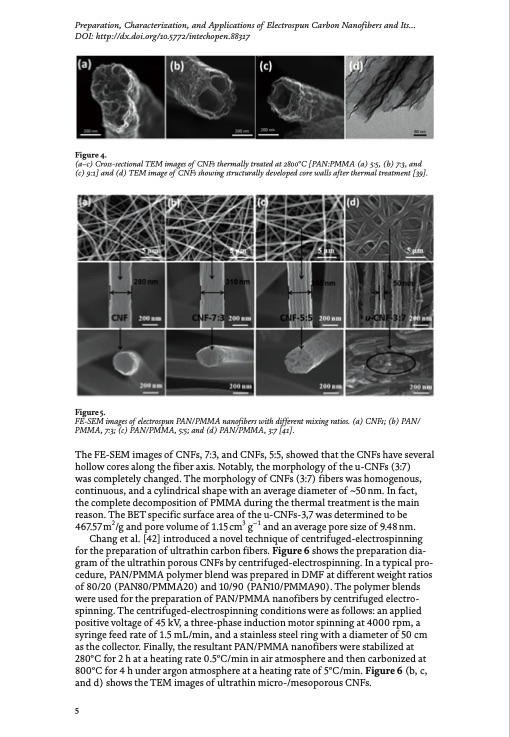
PDF Publication Title:
Text from PDF Page: 005
Preparation, Characterization, and Applications of Electrospun Carbon Nanofibers and Its... DOI: http://dx.doi.org/10.5772/intechopen.88317 Figure 4. (a–c) Cross-sectional TEM images of CNFs thermally treated at 2800°C [PAN:PMMA (a) 5:5, (b) 7:3, and (c) 9:1] and (d) TEM image of CNFs showing structurally developed core walls after thermal treatment [39]. Figure 5. FE-SEM images of electrospun PAN/PMMA nanofibers with different mixing ratios. (a) CNFs; (b) PAN/ PMMA, 7:3; (c) PAN/PMMA, 5:5; and (d) PAN/PMMA, 3:7 [41]. The FE-SEM images of CNFs, 7:3, and CNFs, 5:5, showed that the CNFs have several hollow cores along the fiber axis. Notably, the morphology of the u-CNFs (3:7) was completely changed. The morphology of CNFs (3:7) fibers was homogenous, continuous, and a cylindrical shape with an average diameter of ~50 nm. In fact, the complete decomposition of PMMA during the thermal treatment is the main reason. The BET specific surface area of the u-CNFs-3,7 was determined to be 467.57 m2/g and pore volume of 1.15 cm3 g−1 and an average pore size of 9.48 nm. Chang et al. [42] introduced a novel technique of centrifuged-electrospinning for the preparation of ultrathin carbon fibers. Figure 6 shows the preparation dia- gram of the ultrathin porous CNFs by centrifuged-electrospinning. In a typical pro- cedure, PAN/PMMA polymer blend was prepared in DMF at different weight ratios of 80/20 (PAN80/PMMA20) and 10/90 (PAN10/PMMA90). The polymer blends were used for the preparation of PAN/PMMA nanofibers by centrifuged electro- spinning. The centrifuged-electrospinning conditions were as follows: an applied positive voltage of 45 kV, a three-phase induction motor spinning at 4000 rpm, a syringe feed rate of 1.5 mL/min, and a stainless steel ring with a diameter of 50 cm as the collector. Finally, the resultant PAN/PMMA nanofibers were stabilized at 280°C for 2 h at a heating rate 0.5°C/min in air atmosphere and then carbonized at 800°C for 4 h under argon atmosphere at a heating rate of 5°C/min. Figure 6 (b, c, and d) shows the TEM images of ultrathin micro-/mesoporous CNFs. 5PDF Image | Preparation, Characterization, and Applications of Electrospun Carbon Nanofibers

PDF Search Title:
Preparation, Characterization, and Applications of Electrospun Carbon NanofibersOriginal File Name Searched:
68337.pdfDIY PDF Search: Google It | Yahoo | Bing
Sulfur Deposition on Carbon Nanofibers using Supercritical CO2 Sulfur Deposition on Carbon Nanofibers using Supercritical CO2. Gamma sulfur also known as mother of pearl sulfur and nacreous sulfur... More Info
CO2 Organic Rankine Cycle Experimenter Platform The supercritical CO2 phase change system is both a heat pump and organic rankine cycle which can be used for those purposes and as a supercritical extractor for advanced subcritical and supercritical extraction technology. Uses include producing nanoparticles, precious metal CO2 extraction, lithium battery recycling, and other applications... More Info
| CONTACT TEL: 608-238-6001 Email: greg@infinityturbine.com | RSS | AMP |